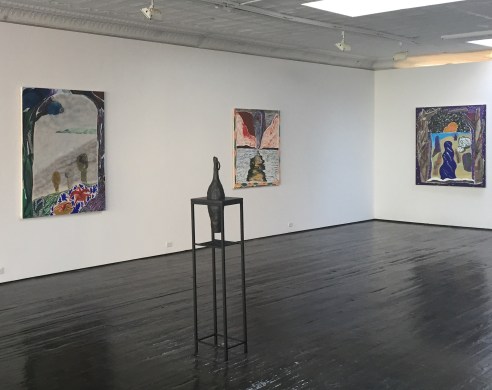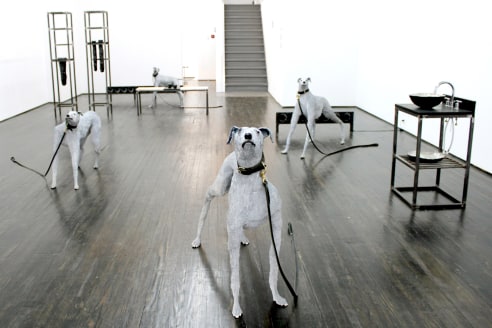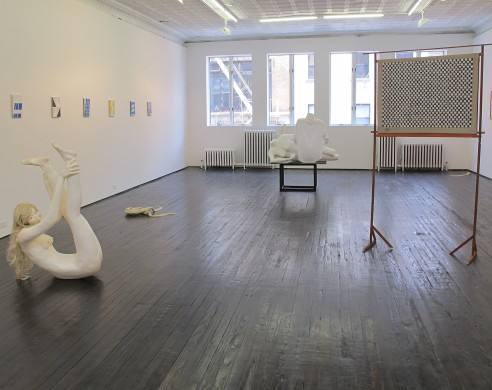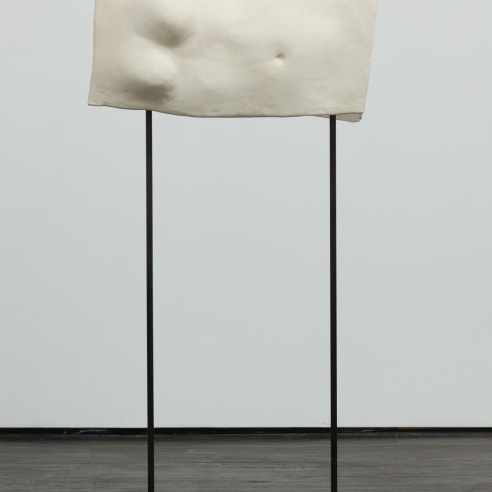
Elizabeth Jaeger in New York Times
Ken Johnson Review of The Whitney's Mirror Cells Exhibition
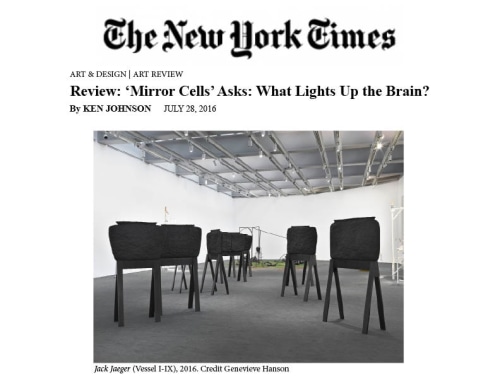
“Mirror Cells,” a presentation of sculptural works by five artists at the Whitney Museum of American Art, is a lively and engaging affair underpinned by an intriguing but insufficiently developed premise.
The title refers to mirror neurons, which were discovered by scientists in the brains of monkeys in the early 1990s and then presumed to exist in all primates, including humans. It seems that when we watch someone performing an action, corresponding neurons in our brains light up, causing us to feel as if we were doing the same thing. That is one reason watching sports is so much fun: mirror neurons cause spectators to feel as if they are doing what the athletes are doing.
The implications for viewing art are unclear but compelling. It’s reasonable to think that mirror neurons are activated when we watch dance, theater and movies, but what about art forms that don’t move?
Consider Win McCarthy’s wonderfully zany constructions resembling architectural models, roughly made of foam board, cardboard, staples, tape, wire mesh and other ordinary materials. They look as if they were created with feverish urgency by a self-taught eccentric or an architect in the throes of a nervous breakdown. Profusely punctuated by small snapshots and reproductions of advertisements posted on thin wooden sticks, they also include poems printed in eye-strainingly small fonts, like one that reads in part:
howcan it possiblybe true?I mean the simultaneity of all this.me herenow.gluing hair to this discomfortinghomunculusbabbling to some stranger about an‘architecture of interiority.’
Projecting intensely self-conscious states of mind, Mr. McCarthy’s works are busily infectious. But given their complexities of form and content, it seems likely that there’s a lot more happening in the minds of his viewers than what mirror neurons can cause.
The exhibition’s organizers — the Whitney associate curators Christopher Y. Lew and Jane Panetta — suppose that mirror neurons are the basis for more than just bodily effects. Their introductory wall text notes, “Associated with feelings of empathy, these cells are believed to help us experience joy and pain that are not our own” and adds that the exhibition “extends to concerns beyond the artist’s studio, sparking empathy on social, political and personal levels.”
These are large and interesting claims, which remain otherwise unsupported. It would have been helpful to enlist an actual neuroscientist to clarify what can and what can’t be attributed to mirror neurons, since this is a matter of ongoing debate among researchers and philosophers.
It might plausibly be argued that mirror neurons are activated by the sensuously hand-modeled surfaces of Elizabeth Jaeger’s large ceramic works — something like the way gestures in Expressionist paintings intimate bodily feelings. Each of nine nearly identical, all-black ceramic vessels is displayed on a custom-made steel sawhorse.
Viewed from the front they appear to be squat, cartoonish vases. Side views reveal them to be flat: They’re not vessels but silhouetted representations of vessels. So there’s an uncanny conflict of perspectives. A museum label notes further that Ms. Jaeger named them all after her grandfather Jack Jaeger, whom she met late in life. Surely it takes more than just mirror neurons to process such complexities of form, reference and metaphor.
No doubt mirror neurons are involved for viewers of the affecting autobiographical videos shown on small boxy monitors in installations by Maggie Lee. Consisting of passages from a 55-minute film about her mother and her family called “Mommy,” one focuses on Ms. Lee’s father, a professional magician, and another on her older sister. In these it’s the combination of Ms. Lee’s voice-over narratives and her montages of old videos that is so captivating, which raises the question — unanswered here — do mirror neurons react to the sound of voices?
Works by Liz Craft include funky, life-size female figures called “Spider Women,” constructed like marionettes out of jointed lengths of wood. Draped in real clothes, they have cartoonish papier-mâché heads and are held upright by networks of black yarn that imitate spider webs. They’re not moving, but they are mildly comical. So there’s another dangling question: are mirror neurons involved in the experience of humor?
What about meaning and interpretation? Rochelle Goldberg’s “No Where, Now Here” is a sort of indoor garden installation. Shiny black ceramic sculptures, resembling pelicans covered in oil, nestle in areas of live bright green grass along with rocky forms, which, like the birds, apparently were cast in clay from compressed tangles of thick rope. Standing frames made of slender lengths of steel outline a surrounding, curvy, pristine architecture, giving the whole a vaguely sacral feeling. If we take all this to be an expression of ecotheology, what have mirror neurons to do with that?
A discipline called neuroaesthetics that has arisen in recent years might provide answers to these and other questions about how our brains make sense of art. Skeptics will say, paraphrasing the painter Barnett Newman, “Neuroaesthetics are for artists what ornithology is for the birds.”
But who knows? As far as art goes, isn’t the real action ultimately in our minds?
